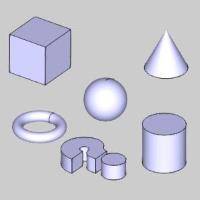 Cone
Cone
Introduction
This topic will explain the Cone function, and the options found in it. This topic will also give brief description of Dynamic Drawing, the Snap Increment function, will describe where to find the Cone function, provide quick steps on how to use it, and provide links to related topics.
The Cone Function
The Cone function creates solid cone primitives. Dynamic Drawing allows you to use sketch handles to modify the location and dimensions of the solid, which can also be defined using data entry. The benefit of Dynamic Drawing is that both methods can be utilized at any time during creation. You can use the sketch handles to roughly define the solid geometry and then use data entry to accurately update the location and dimensions as needed.

Dynamic Drawing
This function supports Dynamic Drawing which allows you to use a combination of sketching and data entry to create the entities. Prior to confirming the desired result in the function, an adjustable preview is visible. These previews can be modified using the sketch handles, data entry, or a combination of both. The benefit of Dynamic Drawing is that you can quickly place and adjust the size to get the approximate result, and then use data entry to update to the exact dimensions, and coordinate values as needed.
|
Preview with Sketch Handles |
Final Entities |

|

|
In the images above, we see the preview of entities which can be adjust with sketch handles, followed by those same entities after they are finalized.
Snap Increment
This function support the use of the snap increment when selecting the location of the entities. The snap increment allows you to get precise results when using mouse selection and helps to reduce data entry modifications.
To learn more, view Snap Increment.
Navigation
To open Cone:
- In the Primitives group, of the Create 3D tab, click
 Cone.
Cone.
The Cone parameters display in the Data Entry Manager.
The Data Entry Parameters
The following values can be set using either data entry or the sketch handles. The snap increment applies when using the sketch handles.
Parameters
- Radius Top - sets the radius of the top of the cone.
- Radius Base - sets the radius of the bottom of the cone.
- Height - sets the total height of the cone.
Origin
The origin determines the coordinate location using the XYZ coordinates of the Active UCS. You can set the origin location using either data entry or the origin sketch handle. The snap increment applies when using the origin handle.
- X - is the X Axis location of the entity origin.
- Y - is the Y Axis location of the entity origin.
- Z - is the Z Axis location of the entity origin.
Important: The XYZ coordinates are in reference to the Active UCS, or user coordinate system.
- OK - confirms the current settings to create the entity as shown in the CAD preview.
- Cancel - closes the function.
Quick Steps - Cone
-
Open the function and define all Data Entry parameters for the entity.
-
Use any combination of data entry or sketch handles to determine the size and location of the entity.
You can modify the snap increment value or turn it off if you are using sketch handles.
To learn more about Dynamic Drawing, view Dynamic Drawing for Solids. -
To create the entity as shown in the CAD preview, in the Data Entry Manager, click OK.
To create another entity, repeat steps 2 and 3. -
To close the function when you are finished, click Cancel.
The feature is added to the CAD Tree.
Tip: When using the Cone function, it is possible to make the Radius Top larger than the Radius Bottom. This allows you to create an inverted cone without having to rotate the cone after it is created.
